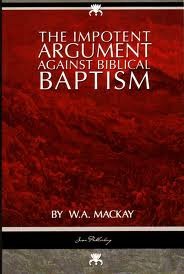| Possible Rebuttals: - I see several ways one can try to avoid the great weight of the cumulative case I have laid out above. The first is to argue that Israel and the church are different entities. This is how John Piper argues. I think the multitude of passages that call us Abraham's offspring, the true Israel, etc, should be weighty enough to determine that there is at least a huge similarity which warrants a continuation of such an important directive as that of marking the visible covenant community. In fact, we know there is. Even if baptism isn't a direct continuation of circumcision but rather a new way of marking God's people, both ideas are still accomplishing the same type of thing. Even if the church is distinct in some ways from the covenant community of Israel, I don't see how we escape the similarity of the requirement to mark community members, and I don't see how we can mark members in a way that is less inclusive than before. The marking of the covenant community now includes women and anyone who professes faith. The gospel expands, not contracts the scope for inclusion. How sad for the covenant community of Christ to expel those whom God formerly included in his community - infants and children - from the markings of the visible community. |
- The third way some try to negate the cumulative case is by pointing to the Greek word used for "baptize," baptizo. In almost all of the literature of the time the NT was written, the usage of baptizo in secular literature meant "to immerse." While that may be the case in secular literature, John Church makes a compelling argument for why this is rebuttal carries little weight in the discussion. You can buy his book "Why Baptize by Sprinkling" on Amazon, or find it online for free. Several of the other sources I link at the bottom also address the issue of baptizo, but I think Church does the best job. Church says,
We have given these illustrations and have said these things in order that we might say this; it is our contention that the word baptizo is not use in its classical sense in the New Testament. A long time before Jesus ever came into the world, this word had undergone a change in meaning and had come to have a very definite religious significance. The Jews had once spoken the Hebrew language and expressed their ideas through this medium. However, a long time before Christ came, the common people of the world had adopted the Greek language as the medium for expressing their thoughts. When the Jews changed over from the use of Hebrew and came to use the Greek language, they did not find a Greek word that exactly conveyed the idea of ceremonial cleansing or purification. They were in need of a word to convey this idea, for it held a very important place in their religious life. In their search for such a word they adopted the Greek word baptizo, and used it to convey the idea of ceremonial cleansing or purification regardless of how it might be done. In the days of Christ they did not use the word in its classical sense, but they used it to express the idea of cleansing or purification. When a Jew was baptized he was cleansed. This was the major meaning of the word to him. He was not so much interested in how it was done as what was done. He might be baptized either by sprinkling, pouring or immersion, but the thing that counted most with him was the fact that he had been cleansed. This was the idea the word conveyed to his mind. This was the way he thought about it. A careful study of the way the word is used in the New Testament will verify the thing we have been saying. The translators of the New Testament recognized this fact and, in many instances in the King James version, they use the English word wash where the Greek gives it baptizo. We have already called attention to three instances in the New Testament where this is the case. In Hebrews 9:10 the Greek gives the word baptizo, but in English it is translated divers washings. In Mark 7:4 the Greek word baptizo is used but in our version it is translated washing. In Luke 11:38 the Greek used the word baptizo but in English it is translated washed.
In fact, anywhere you find the word baptize in the New Testament you can take that word out and insert either the word cleanse or purify and it does not change the meaning of the sentence in the least. As an illustration let us take the statement of Christ in Acts 1:5 “John indeed baptized (purified or cleansed) with water; but ye shall be baptized (purified or cleansed) with the Holy Ghost not many days hence.” Now while you can do that, and it does not change the meaning, yet you could not insert the word immerse and not change the meaning of many sentences. For the question would naturally arise, immerse in what? There is no water in the word immerse. You might immerse a person in many different things. Neither is there any water in the word sprinkle, for the same question would arise. Sprinkle with what? However, there was water implied in the use of the word baptize as the Jews understood it, for it had come to convey the idea of ceremonial cleansing with water. When a Jew had water sprinkled on him, with a bunch of hyssop, he was baptized. He had been purified or cleansed. This was the meaning of the word as it was used in the days of Jesus. This word had come to have this definite meaning a long time before Christ ever came. It had been used to convey this idea to the minds of the people. This is illustrated in the case we have mentioned from the book of Judith. She washed herself at the horse trough by sprinkling, but the historian calls it baptism. Josephus tells us of people that were baptized and he says it was done by sprinkling, and yet he uses the Greek word baptizoin speaking of it. These two illustrations show us how the word was used by reliable Jewish writers at that time. It is not used in its classical sense but has a different meaning. It conveyed a definite idea to the minds of the people in the days of Christ. When they heard and used the word they were thinking of cleansing or purification, regardless of how it might be done. Now this is the meaning we are most concerned about. We are not so much interested in how Socrates used it and what it meant to him, but we are very much concerned about how Jesus used it and what it meant to the people that heard him speak.
- The fourth argument I’ve heard is that since circumcision was still advocated by some in the early church, baptism was clearly not intended to take the place of circumcision. However, I don’t think this is a good argument. First, even if baptism isn’t a continuation of circumcision, it doesn’t mean it couldn’t run parallel to it. God marked his people Israel in one way, and he marks his people in the church in another way. Continuous or parallel, it doesn’t matter.
But I don’t think we need to even fall back that far. It makes complete sense to me that the Jews in the early church would have difficulty leaving things behind. Yes, Paul mentions circumcision, but he also has to work hard to stop the churches from fighting over all sorts of emphases on works, observing feasts, etc. There was a lot of conflation of the old and new, the law and grace going on. I would expect to see circumcision continued by some even if it was replaced by baptism, as circumcision was a law in the OT and Christian Jews and judaizers had a tough time being free in Christ and moving into his work and his grace.
- The final way I see to escape the case I have put forward is to say, "Yes, the evidence is very weighty for sprinkling and/or infant baptism. However, I just think that the symbolism changed." Fair enough. It is possible that the symbolism did change. I cannot provide a zinger to show that baptism should be done the way I have advocated. All I can do is provide the full weight of a very cumulative case. Christ's burial and resurrection are very important and I can understand the beauty that comes along with the baptism of immersion and the baptism only of believers (though I think it is less beautiful than the alternative I have offered). I cannot show with 100% certainty that the case I have laid out is correct. But if you are unable to build a weighty rebuttal to what I have put forward, I think it is important to take another look at the evidence and do some serious searching as to why you believe what you do, and what your view of and parameters for truth and faith are. One of the biggest complaints lodged against Protestants by the Catholic and Orthodox churches today is that we have so many denominations because we all like to interpret things on an individual basis rather than in light of church history and the broader context. We like to pick the parameters for what we believe, and when faced with a weighty case against us, we fall back to our own interpretation and feelings. I feel as though there are many well-intentioned Christians who, in an attempt to paint a beautiful Christocentric picture centered around individual choice, demolish the intended picture of the full godhead, the sovereignty and power of God in his work, and the inclusion of our children into the covenant community. You lose far more than you gain when you change God's intended depiction.
PREVIOUS: Part 5: Church History NEXT: Part 7: Conclusion and Resources





 RSS Feed
RSS Feed